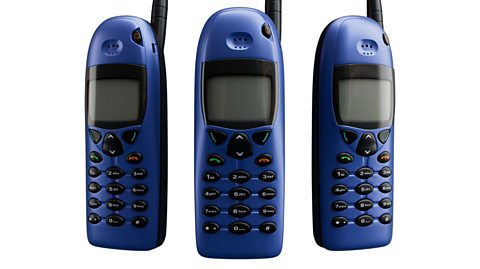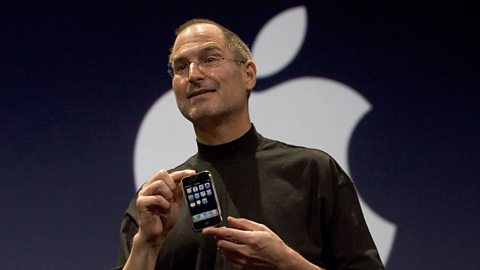The development of the phones in our pockets happens at such a pace, keeping up to speed on their history can be tricky.
Events such as the Mobile World Congress - where the most remarkable advances in technology are on display, from phones we can wrap around our wrist to transparent laptop screens - show just how big a deal the industry is. Compared to other popular products, such as TVs and bicycles, mobile phones and smartphones are still so young; their story only began in the final part of the 20th Century. But itтs definitely a history worth calling up, as ДѓЯѓДЋУН Bitesize discovers.
When was the first mobile phone invented?
The first call made from a mobile phone happened on 3 April 1973 in New York City. It was made by the engineer Marty Cooper, who worked at the telecommunications firm Motorola and the call was to a rival at his companyтs competitor, Bell Laboratories.

The prototype device Cooper called from was very different from the slim handsets we slip into our pockets and bags without a second thought today. Eleven years later, it finally went on public sale under the name Motorola Dynatac 8000X. In 1984, the Dynatac, known as a cell phone rather than a mobile, would cost you $3,995 - thatтs approximately $11,700 or ТЃ9,500 today. At the time, the average weekly wage in the UK was around ТЃ117.
For that price tag, mobile phone owners could telephone other people - but that was it. Texting, social media and camera capabilities would come (much) later. Its battery took 10 hours to charge, providing 30 minutes of use and a 15cm (6in) antenna had to be extended before making a call. It also weighed 790g (1.7lbs) - around four times as heavy as an iPhone.
What was the first generation of popular mobile phone?
In the beginning, mobile phones were largely used by businesspeople who were on the go, needed to be in contact with clients and colleagues throughout the day and - perhaps most significantly - could afford them. They used what are seen as the first generation of mobile phone, affectionately referred to as 'bricks' today due to their large size in comparison to today's models.

The second generation of mobile phone became a more regular sight in the street. These phones used the new 2G signal (which also means тsecond generationт) and when they arrived in the 1990s, more teenagers became mobile phone users. The ability to text was available for the first time, on handsets which were now a lot smaller and easier to handle than the Dynatac 8000X.
From 1997, some mobile phones included games (Snake was very popular!) and it was in 1999 that cameras appeared on mobiles for the first time.
When was the internet first available on mobile phones?
The 1990s saw many developments in mobile phone technology and it was in 1996 that the internet appeared on a handset for the first time. This particular device, the 9000 Communicator, was made by the Finnish firm Nokia.
Regarded as revolutionary, the Communicator could be opened up to reveal a keyboard and screen. It even featured prominently in the 1997 film The Saint. Val Kilmer played the title hero - using his phone to get him out of a pickle whenever necessary.
When did smartphones come out?
The question: тWhat was the first smartphone?т can be tricky to answer as many experts and mobile phone historians have different answers. This is because elements of what make up a smartphone, such as apps - or the ability to send emails - existed on different models at different times.

One device that is often seen as the first smartphone is the IBM Simon from 1994. It had a touchscreen, ability to send a fax, and also an email and calendar function. The BlackBerry, launched in 1999, is also seen as as having smartphone capabilities. It had a keyboard instead of the traditional telephone buttons on its casing and was useful for sending and receiving emails.
The smartphone as we are more likely to know it today first appeared in January 2007, when Steve Jobs of Apple announced the iPhone to an excited crowd in San Francisco. It combined the music player, the iPod, with internet capabilities and a touch screen mobile phone. In its second version, the iPhone 3G, users were also able to download apps of their choice from an online store.
Other smartphones have followed in the wake of the iPhone. Newer, updated versions of these devices are announced on a regular basis and as technology has moved on, we can now watch live TV, films and sporting events - without too much trouble - from wherever we are in the world.

Mobile phones and smartphones: A timeline
- 1984: Motorola's Dynatac 8000x is the world's first commercially available mobile phone.
- 1992: First SMS (Short Message Service) - also known as a text - is sent.
- 1994: First mobile game appears on the Hagenuk MT-2000 - a version of the ever popular Tetris.
- 1997: Nokia introduces the popular Snake game.
- 1999: BlackBerry phones appear for the first time. Popular for their messaging service.
- 1999/2000: Mobile phones are on the market with a back-facing camera, perfect for taking a family photo.
- 2001: The 3G (third generation) phone network launches.
- 2003: Phones with a front-facing camera become popular, enabling us to take a selfie. They first appeared in Japan in 1999.
- 2007: The first Apple iPhone is launched.
- 2008: The first Android smartphone is launched.
- 2013: Acer's Liquid S2 is the first phone to include a 4K camera for high-definition images.
- 2015: The first iPhone to record 4K video appears.

This article was published in February 2024
Four incredible phone calls in history
From the first ever call to one out of this world, ДѓЯѓДЋУН Bitesize takes a look at iconic phone calls in history

The British scientific discoveries quiz
How much do you know about the inventions and theories pioneered in the UK?

Everyday things we do without realising (and why)
ДѓЯѓДЋУН Bitesize takes a look at some of the things we do everyday without realising and why we do them.
